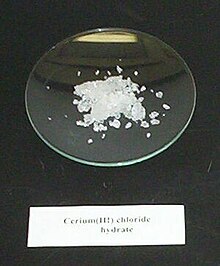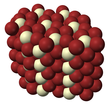
Back كلوريد السيريوم الثلاثي Arabic سریوم (III) کولورید AZB Chlorid ceritý Czech Cer(III)-chlorid German Ceria (III) klorido Esperanto سریم (III) کلرید Persian Ceriumkloridi Finnish Chlorure de cérium(III) French सेरियम(III) क्लोराइड Hindi Serium(III) klorida ID

| |||
| |||
| Names | |||
|---|---|---|---|
| IUPAC names
Cerium(III) chloride
Cerium trichloride | |||
| Other names
Cerous chloride
| |||
| Identifiers | |||
| |||
3D model (JSmol)
|
|||
| ChEBI | |||
| ChemSpider | |||
| ECHA InfoCard | 100.029.298 | ||
| EC Number |
| ||
| 1828 | |||
PubChem CID
|
|||
| UNII |
| ||
CompTox Dashboard (EPA)
|
|||
| |||
| |||
| Properties | |||
| CeCl3 | |||
| Molar mass | 246.48 g/mol (anhydrous) 372.58 g/mol (heptahydrate) | ||
| Appearance | fine white powder | ||
| Density | 3.97 g/cm3 | ||
| Melting point | 817 °C (1,503 °F; 1,090 K) (anhydrous) 90 °C (heptahydrate, decomposes) | ||
| Boiling point | 1,727 °C (3,141 °F; 2,000 K) | ||
| Solubility | soluble in alcohol | ||
| +2490.0·10−6 cm3/mol | |||
| Structure | |||
| hexagonal (UCl3 type), hP8 | |||
| P63/m, No. 176 | |||
| Tricapped trigonal prismatic (nine-coordinate) | |||
| Hazards | |||
| GHS labelling: | |||
  
| |||
| Danger | |||
| H315, H318, H319, H335, H410 | |||
| P261, P264, P271, P273, P280, P302+P352, P304+P340, P305+P351+P338, P310, P312, P321, P332+P313, P337+P313, P362, P391, P403+P233, P405, P501 | |||
| Flash point | Non-flammable | ||
| Related compounds | |||
Other anions
|
Cerium(III) oxide Cerium(III) fluoride Cerium(III) bromide Cerium(III) iodide | ||
Other cations
|
Lanthanum(III) chloride Praseodymium(III) chloride | ||
Except where otherwise noted, data are given for materials in their standard state (at 25 °C [77 °F], 100 kPa).
| |||
Cerium(III) chloride (CeCl3), also known as cerous chloride or cerium trichloride, is a compound of cerium and chlorine. It is a white hygroscopic salt; it rapidly absorbs water on exposure to moist air to form a hydrate, which appears to be of variable composition,[1] though the heptahydrate CeCl3·7H2O is known. It is highly soluble in water, and (when anhydrous) it is soluble in ethanol and acetone.[2]
- ^ Several great producers such as Alfa and Strem list their products simply as a "hydrate" with "xH2O" in the formula, but Aldrich sells a heptahydrate.
- ^ Paquette, L. A. (1999). Coates, R. M.; Denmark, S. E. (eds.). Handbook of Reagents for Organic Synthesis: Reagents, Auxiliaries and Catalysts for C-C Bond Formation. New York: Wiley. ISBN 0-471-97924-4.
© MMXXIII Rich X Search. We shall prevail. All rights reserved. Rich X Search

